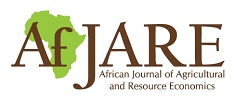African Journal of Agricultural and Resource Economics
(AfJARE)
Journal Africain d’Économie Agricole et des Ressources
(JAEAR)
Published by the African Association of Agricultural
Economists (AAAE)
ISSN 1993-3738
Volume 16, No. 3 (September 2021)
Livestock, particularly cattle, are an integral part of livelihoods in rural sub-Saharan Africa. However, diseases such as African animal trypanosomosis (AAT) have limited the potential of this important sector in the rural household economy.
This paper evaluates output supply and input factor demands for livestock products in the Southern rangelands of Kenya. A flexible translog profit function that permits the application of the primal approach to the output supply and factor demand analysis was estimated using household-level data.
The inverse farm size and productivity relationship (IR) is a recurring theme in the literature. However, most previous studies were undertaken within a setting of mixed cropping systems. In this article, we investigate the effect of farm size on productivity within the context of a perennial mono-cropping system, acute competition for farmland, frequent subdivision of farms and declining yields.
This study investigates the driving factors that influence farmers’ decisions to adopt modern agricultural inputs (MAI) and how this affects farm household welfare in rural Rwanda. To account for heterogeneity in the MAI adoption decision and unobservable farm and household attributes, we estimate an endogenous switching regression (ESR) model.
Weather is an important determinant of household well-being in rural Sub-Saharan Africa. This paper explores the relationship between novel measures of cropping-season weather conditions and household food consumption in rural Niger, and how household coping mechanisms mediate that relationship.
This study examines the complementarity and substitutability effect of private investment and public expenditure on agricultural productivity in Nigeria for the period 1978 to 2018. The study employs the vector error correction modelling (VECM) technique, and the estimate shows that government expenditure on the agricultural sector had the most significant effect on agricultural productivity, followed by commercial bank credit for the agricultural sector.
